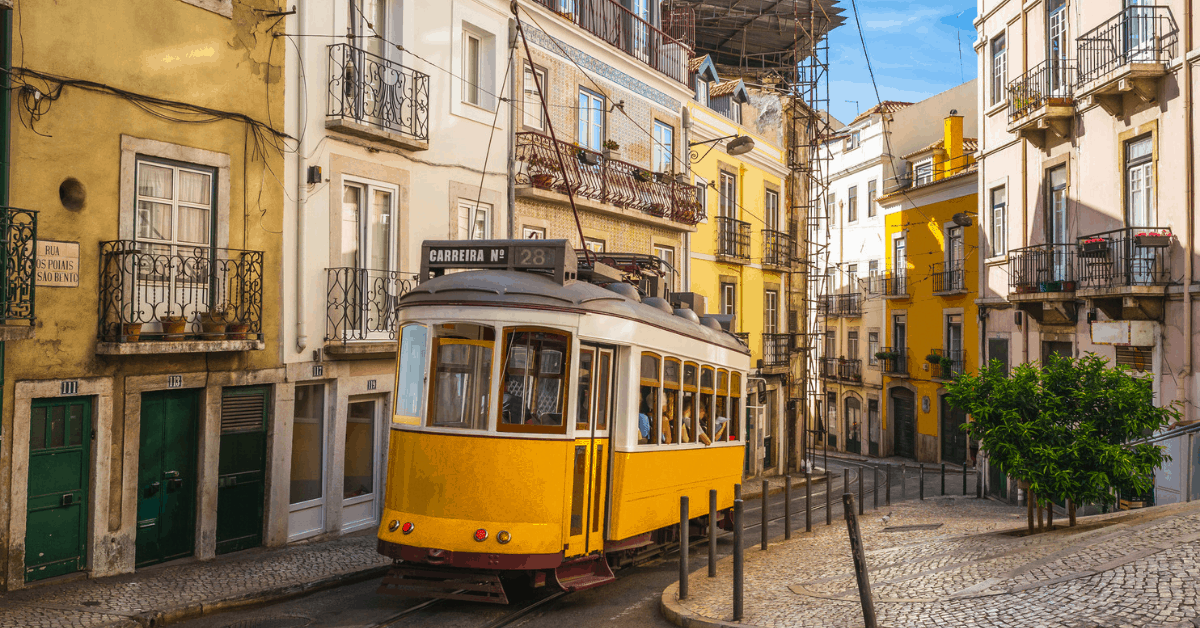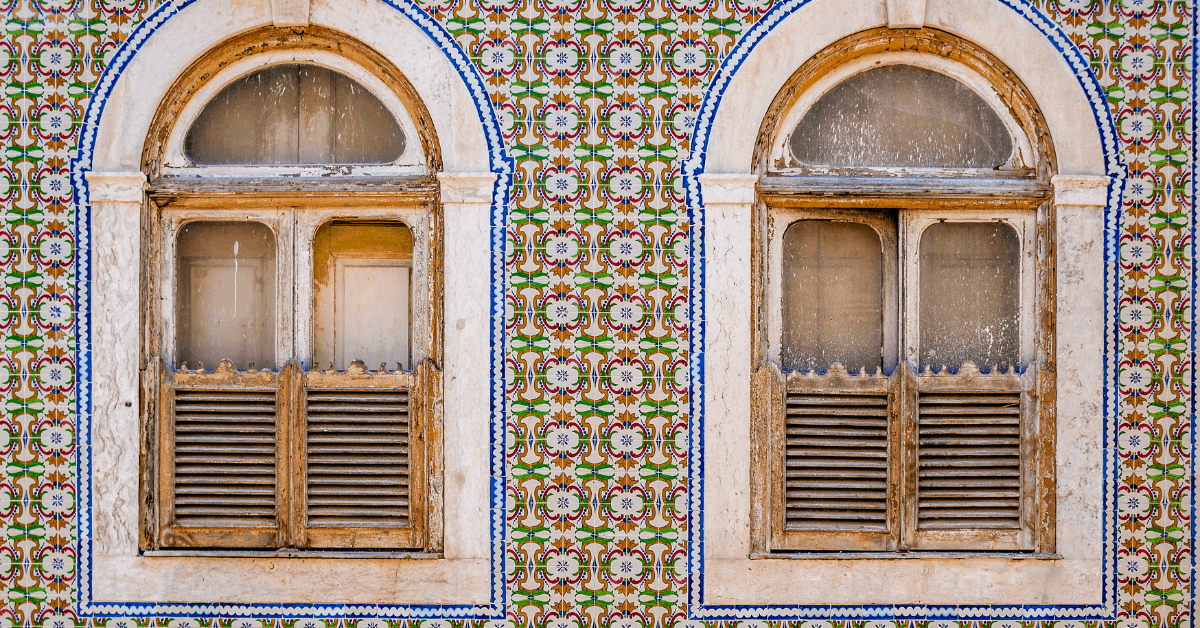Let Lisbon’s unique culture help guide you on a tour of the city’s best neighborhoods.

Lisbon became the capital and economic center of Portugal thanks to its strategic geographical location on the Tagus estuary, allowing easy access to Northern Europe, Africa, and the Mediterranean. This made the city one of the most culturally diverse in Europe, and one of the most prosperous until 1755 when an earthquake flattened the city center and decimated its economy. As a result of this dynamic history, Lisbon is a fusion of East and West, old and new. From the language to the iconic ceramic tiles to the distinctive music scene, it is a city like no other in Europe.
CHIADO
The Chiado district became the meeting place for Lisbon’s cultural elite after the city’s opera house, Teatro Nacional São Carlos, opened there in 1792. Since then, the neighborhood has gone through many transformations but has remained a favorite for shopping, cafes, and cultural diversions.
Archeological Museum of Carmo
This centrally-located museum is based in the former Convent of the Carmo, a gothic church that was once the biggest in Lisbon before it was destroyed in the 1755 earthquake. The convent’s ruins were repurposed as a museum and event space that houses a mishmash of ancient Portuguese artifacts, architectural elements, funerary objects, 17th-century oil paintings, and the show stoppers: two mummified people sitting (yes, sitting) in glass vitrines. In addition to the ancient artifacts, the museum showcases work by contemporary Portuguese artists.
At night, the museum sells separate tickets to a music and light show that is projected onto the walls of the open-air courtyard. The multi-sensory production offers a look at the many iterations of the convent before its destruction, along with a fantastical retelling of the history of Lisbon and Portugal from the late 14th-century until the present.
What to do nearby
Get a taste of the Chiado district’s former bohemian glory by grabbing a “cafe con leite”, a short coffee with milk, at Cafe A Brasileira, the old haunt of the famous Portuguese poet Fernando Pessoa. For dinner, make reservations at Duque Restaurante, a cozy tavern that serves traditional Portuguese fare. Or if you want something lighter, pop around the corner and grab a seat at their sister tapas bar, Duque da Rua, for some snacks and Fado, sung by a group of six local musicians. Those with a keen eye will be able to spot the painted portrait of all the “fadistas” hanging up somewhere in the restaurant.
BAIRRO ALTO
Bairro Alto, once the epicenter of journalism in Lisbon, is now the number one spot in town for nightlife and specifically “Casas de Fado”, or fado houses, which are restaurants that offer live Fado performances along with traditional Portuguese food. Come here during the day for the gallery scene, and come back at night for music, drinks, and dancing.
Galeria Zé dos Bois
Galeria Zé de Bois, known to locals as ZDB, is a not-for-profit performance, visual art, and project space that includes a two-floor gallery building, a performance venue, and a bookstore. ZDB produces 150 events a year ranging from educational programs, plays, dance performances, lectures, and concerts with local and international artists. Entrance to the gallery is 3 euros and the ticket is good for two months.
Galeria Graça Brandão
Come be inspired by one of the most beautiful gallery spaces in Lisbon with a multi-floor exhibition space, screening room, and a roster that emphasizes artwork by Portuguese and Brazilian artists. The gallery originally opened its doors up north in Porto back in 2002 but relocated to its current Bairro Alto location in Lisbon in 2006. It hosts a rotating program of new exhibitions approximately every two months including special events.

What to do nearby
Make a reservation for Fado and dinner at Café Luso, one of the city’s oldest Fado houses located in the cellar of a former 18th-century palace. After dinner, bar hop your way down the hill starting with Pavilhão Chinês (Chinese Pavilion), an eclectically-decorated bar located in a former grocery that serves classic cocktails. Make a stop for a Portuguese wine tasting and a cheese plate at The Old Pharmacy, before continuing down the hill towards Praça Luís de Camões, a square named after the famous playwright dubbed “the Shakespeare of Portugal”.
ALFAMA
The Alfama is Lisbon’s oldest district, and during Moorish rule, the city’s only neighborhood. As the city expanded beyond the Alfama, it became known as a run-down district, which catered mostly to the rough-around-the-edges population of sailors who worked on the nearby docks. However, thanks to its great views of the city, old architecture and charming labyrinth of streets that were untouched by the 1755 earthquake, the Alfama is now one of the most popular tourist destinations.
Museu do Fado
You can’t understand the history of Lisbon without learning about Fado music, a genre of mournful ballads sung with “saudade”, a Portuguese word that roughly translates to a sense of longing. While most of the best Fado clubs are now in the Bairro Alto district, the music has its origins near the docks of the Alfama where the first singers were sailors singing to other sailors. The Fado Museum is now housed in this district to honor its history and act as a document to the ever-evolving art form.
Museu Nacional do Azulejo (National Tile Museum)
While not technically in the Alfama neighborhood, the National Tile Museum is a six-minute drive north along the Avenida Dom Henrique. The museum, located in the former Madre de Deus Convent, is a must-see to understand the origin of Portugal’s iconic tilework. Learn about the evolution of the ceramic craft and glazes from the 16th-century all the way up to the present. Don’t miss the top-floor of the museum, which hosts a wall-sized tile map of old Lisbon as seen from the estuary.

What to do nearby
Get lost walking up and down the windy streets of the Alfama district. Check out the local flea market on Tuesdays and Saturday at the Jardim Boto Machado. Take a break from climbing the neighborhood’s many stairs at a sidewalk cafe for some freshly grilled sardines with a carafe of “vinho verde”, or green wine which is known for its bubbles and light flavor. Admire the spiked facade of Casa dos Bicos, home to the José Saramago Foundation that honors the Portuguese Nobel Prize winner, and one of the few large buildings to survive the earthquake. Around sunset, visit the Castelo de São Jorge for panoramic views of central Lisbon and the Tagus river.
ALCÂNTARA
The Alcântara district got its name from the Arabic word “al-qntara”, which means the bridge, after the Ancient Roman bridge that connected it to Belém up until the mid-1700s. Since then, the district evolved from being the home of the Portuguese monarchy to a center for industrial textile factories in the 19th-century. Now, due to recent gentrification efforts, the neighborhood hosts a range of bars, restaurants, and shops, as well as the best views of the Ponte de 25 Abril, the large red suspension bridge that crosses the Tagus.
You might notice that the Ponte de 25 Abril looks a lot like the Golden Gate Bridge. While there is no architectural relationship between the two, the bridge was built by the same company that designed the Bay Bridge connecting San Francisco to Oakland. They had previously lost the bid to create the Golden Gate Bridge, which might explain the choice of color.
Museu Nacional de Arte Antiga
There is something for everyone at Lisbon’s National Museum of Ancient Art, which has one of the world’s largest art collections. The museum specializes in ancient and historical Portuguese painting, illuminated manuscripts, metalwork, ceramics, furniture, and textiles. After your visit, grab lunch or coffee at the museum’s restaurant, Restaurante MNAA, which boasts a terrace overlooking the Tagus estuary, the Christ the King Sanctuary, and the 25th de Abril Bridge.
What to do nearby
A quick drive or 20-minute walk west on Avenida Brasilia from the MNAA will bring you to the LX Factory, a former textile factory that has been repurposed into a hub for creative entrepreneurs, with shops and a range of rotating cultural events. Check out The Therapist, a wellness center for those looking for some self-care. This one-stop-shop offers healthy meals, workshops, and naturopathic treatments like massages. If you’re more in the mood for some seafood, walk a couple of blocks to the popular mom-and-pop restaurant O Palácio for plates of shellfish. Don’t forget to try the grilled barnacles, a local treat that is harvested from the caves in the nearby Sintra region.
BELÉM
The Belém district is a 20-minute drive west from the city center and, due to its remote location, began as a fishing and farming village. It was eventually taken over by the Portuguese monarchy as the city continued to expand westward and is now home to some of the city’s most iconic architecture including the Jerónimos Monastery, a large religious compound that took 100 years to complete, and the Tower of Belém, a Manueline-style military fort that was built in the 16th-century. Despite its distance, this neighborhood is still a popular destination for its many parks and high density of cultural institutions.
Museu Coleção Berardo
In April 2019, this museum was reported as being the Most Visited Museum in Portugal by The Art Newspaper. It is no wonder, thanks to its extensive collection of artwork from 1900 to the present day, with an emphasis on Minimalism and Conceptual Art. The museum hosts two permanent exhibitions and a program of four temporary exhibitions featuring work by national and international artists. Plan to spend a couple of hours here to make sure you cover all five floors. Check their website for a schedule of events, openings, musical performances, and other special programming.
What to do nearby
Visit the Tower of Belém and the Jerónimos Monastery, but skip the National Archaeological Museum housed next to the monastery. Instead, recharge your batteries with a trip to Pastéi de Belém, the famous pastry shop that invented Lisbon’s custard-filled pastry, the “pastel de Belém”. Much like Champagne is to sparkling wine, these pastries are only called “pastel de Belém” in this district, but you will see them all around Lisbon and the rest of Portugal as “pastel de nata”. Insider tip: cut the line at the cafe by grabbing a table inside, then order a box (or two) to go.



